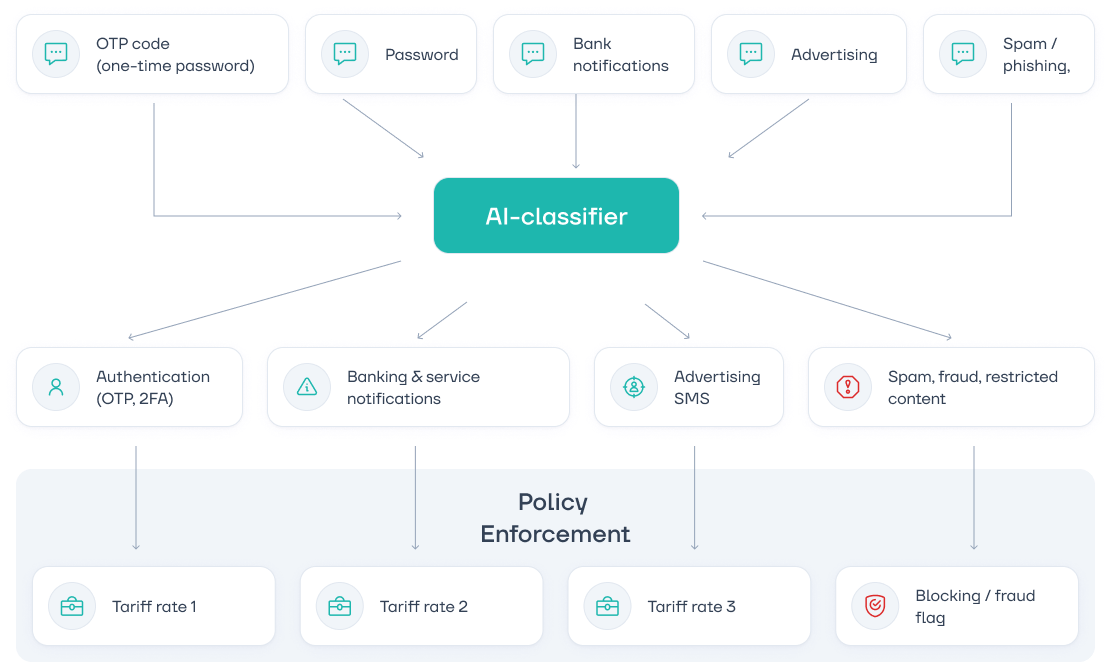AI Takes on SMS Fraud: Successful Pilot Paves the Way for Full Deployment
20 june 2025

An AI-driven solution is helping telecom operators detect SMS fraud with greater speed and accuracy. A recent pilot with a Middle Eastern client proved the effectiveness of this technology, and now, it’s ready for a wider rollout.
Turning SMS Traffic into Revenue at Zain Kuwait
To speed things up, the Eastwind team set out to automate the routine. The idea: if AI could learn to spot one-time passwords (OTPs) in SMS traffic, it could flag SIM box messages faster and keep filtering rules up to date. We brought in data analysts and got started on building the AI module.
Here’s what’s under the hood:
To train the system, we used Named Entity Recognition (NER)—a method that helps the model identify and classify messages based on set criteria.
We trained the model to understand message context, detect disguised OTP codes, classify messages, and flag fraud in the traffic stream.
.png)
To bypass filters, fraudsters disguise OTP codes using symbols, letter substitutions, and unconventional spellings
For the pilot, we focused on traffic from regular subscriber numbers, the kind SIM boxes typically use to hide OTP codes. Messages that were clearly safe, like short numeric strings under four characters, were filtered out from the start.
We ran the test on a month’s worth of archived messages. The AI model sorted the traffic and generated reports, which our experts then reviewed to check for accuracy.
.png)
During post-analysis, the AI model generates daily traffic reports each morning, based on the previous day’s analysis results
For now, the AI runs in post-analysis mode, generating daily reports based on the previous day’s traffic. This allows Eastwind specialists to react faster to new threats and keep fraud protection sharp and up to date.
The client involved in the pilot was impressed with the results and decided to move forward with full integration of the AI module into their EW SMS Firewall. Once deployed, the system will automatically receive and analyze traffic in real time, producing reports without any manual steps. All that’s left is to beef up the infrastructure by adding a server with the same specs as the existing EW SMS Firewall machine.

AI-based fraud classification also opens the door for operators to implement dynamic pricing based on message type
Real-time AI analysis requires serious infrastructure: high-performance servers or GPUs to keep up with the load. For operators handling large volumes of A2P traffic, the investment pays off. For smaller volumes, daily post-analysis usually does the trick.
While we’re getting ready to roll out the AI module with an operator in the Middle East, another deployment is already underway in Africa, where the module is being integrated directly into EW SMS Firewall from the start.
Learn more about what EW SMS Firewall and AI module can do
More News
How the Idea Was Born
Mobile operators and SMS aggregators rely on e EW SMS Firewall to protect their networks from fraud and generate revenue from A2P traffic. The system has proven highly effective, preventing losses that can reach hundreds of thousands of dollars each month. But much of its success depends on the experts who manage traffic as part of Eastwind’s Managed Services. One of their core tasks is analyzing fraud patterns and identifying scam tactics—the process is time-consuming and slows down response times.Turning SMS Traffic into Revenue at Zain Kuwait
To speed things up, the Eastwind team set out to automate the routine. The idea: if AI could learn to spot one-time passwords (OTPs) in SMS traffic, it could flag SIM box messages faster and keep filtering rules up to date. We brought in data analysts and got started on building the AI module.
How the AI Module Works
The AI/ML module is a built-in component of EW SMS Firewall, created to automatically analyze SMS traffic and user behavior in order to detect A2P fraud and spot SIM boxes on telecom networks.Here’s what’s under the hood:
- An NLP (Natural Language Processing) model that scans SMS content and uncovers hidden authorization codes.
- A cross-lingual XLM-RoBERTa model, which can work across multiple languages and pinpoint specific elements in messages—in this case, one-time passwords (OTPs).
To train the system, we used Named Entity Recognition (NER)—a method that helps the model identify and classify messages based on set criteria.
We trained the model to understand message context, detect disguised OTP codes, classify messages, and flag fraud in the traffic stream.
.png)
To bypass filters, fraudsters disguise OTP codes using symbols, letter substitutions, and unconventional spellings
For the pilot, we focused on traffic from regular subscriber numbers, the kind SIM boxes typically use to hide OTP codes. Messages that were clearly safe, like short numeric strings under four characters, were filtered out from the start.
We ran the test on a month’s worth of archived messages. The AI model sorted the traffic and generated reports, which our experts then reviewed to check for accuracy.
.png)
During post-analysis, the AI model generates daily traffic reports each morning, based on the previous day’s analysis results
What the Pilot Showed
After a month of testing, the results were clear—the AI module did exactly what it was designed to do:- It accurately detected messages with hidden OTP codes
- Report generation was fully automated
- Every day, the team received ready-made datasets to update filtering rules and blacklists
For now, the AI runs in post-analysis mode, generating daily reports based on the previous day’s traffic. This allows Eastwind specialists to react faster to new threats and keep fraud protection sharp and up to date.
The client involved in the pilot was impressed with the results and decided to move forward with full integration of the AI module into their EW SMS Firewall. Once deployed, the system will automatically receive and analyze traffic in real time, producing reports without any manual steps. All that’s left is to beef up the infrastructure by adding a server with the same specs as the existing EW SMS Firewall machine.
What’s the Future of Real-Time Analysis
The AI module has the potential to analyze SMS traffic in real time, applying filtering rules on the fly, instantly blocking fraudulent messages, and continuously learning to anticipate new fraud patterns.
AI-based fraud classification also opens the door for operators to implement dynamic pricing based on message type
Real-time AI analysis requires serious infrastructure: high-performance servers or GPUs to keep up with the load. For operators handling large volumes of A2P traffic, the investment pays off. For smaller volumes, daily post-analysis usually does the trick.
While we’re getting ready to roll out the AI module with an operator in the Middle East, another deployment is already underway in Africa, where the module is being integrated directly into EW SMS Firewall from the start.
Learn more about what EW SMS Firewall and AI module can do
